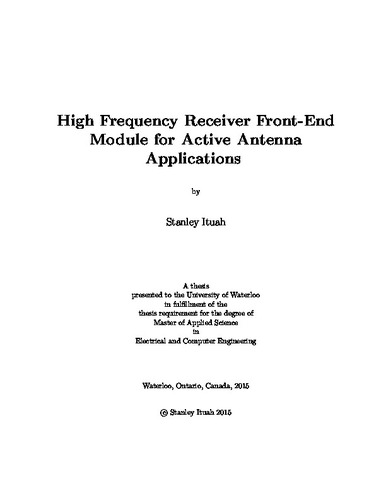| dc.contributor.author | Ituah, Stanley | |
| dc.date.accessioned | 2015-09-15 14:27:32 (GMT) | |
| dc.date.available | 2015-09-15 14:27:32 (GMT) | |
| dc.date.issued | 2015-09-15 | |
| dc.date.submitted | 2015-09-14 | |
| dc.identifier.uri | http://hdl.handle.net/10012/9664 | |
| dc.description.abstract | This research is based on the analysis and development of an integrated receiver front-end module for high gain active antenna systems at the K-band (20GHz). In the design of conventional satellite receivers (such as reflector antennas), the system is usually specified by the gain/directivity, gain-to-temperature ratio (G/T) and radiation pattern requirements. The challenge in high gain active antenna systems development, in addition to beam-forming/beam-steering requirements, is to develop transmit/receive modules which will meet the power, noise and radiation pattern requirements of the conventional antenna. In order to guarantee an optimal design, it is important to be able to translate the specifications from the system level to the transistor level. The focus is on the development of a single-channel CMOS-based integrated receiver module.
The G/T requirement is analysed to derive the noise figure and gain specifications for the low noise amplifier(LNA). An LNA design in 65nm CMOS is demonstrated to achieve a 2.6dB noise figure and uses only 7mW of DC power. The digital phased shifter specifications are studied. The generation of "quantization lobes" is analysed and used to estimate the number of bits based on side-lobe level requirements. The design of a 5-bit digital phase shifter based on quadrature signal modulation and a unique digital control logic is presented and tested at 20GHz. The phase shifter is shown to achieve <5.5 degree rms phase error and >10dB input and output return loss between 16-21GHz. The effect of pattern tapering on the side-lobe level is investigated and used to specify the minimum dynamic range for a variable gain amplifier (VGA). A VGA design is demonstrated to meet this dynamic range with low phase-frequency variation.
A schematic level design of the proposed single-channel array is studied featuring a hybrid coupler and switch for polarisation requirements, as well as a low-voltage bandgap reference circuit. Simulations results verify that the receiver can be used to generate two hands of polarisation (right and left) with <1.1dB axial ratio. | en |
| dc.language.iso | en | en |
| dc.publisher | University of Waterloo | |
| dc.subject | Integrated Circuits | en |
| dc.subject | Active Antenna | en |
| dc.subject | Phased Array | en |
| dc.subject | k-band | en |
| dc.subject | phase shifter | en |
| dc.subject | variable gain amplifier | en |
| dc.subject | satellite communication | en |
| dc.subject | CMOS | en |
| dc.title | High Frequency Receiver Front-End Module for Active Antenna Applications | en |
| dc.type | Master Thesis | en |
| dc.pending | false | |
| dc.subject.program | Electrical and Computer Engineering | en |
| uws-etd.degree.department | Electrical and Computer Engineering | en |
| uws-etd.degree | Master of Applied Science | en |
| uws.typeOfResource | Text | en |
| uws.peerReviewStatus | Unreviewed | en |
| uws.scholarLevel | Graduate | en |

